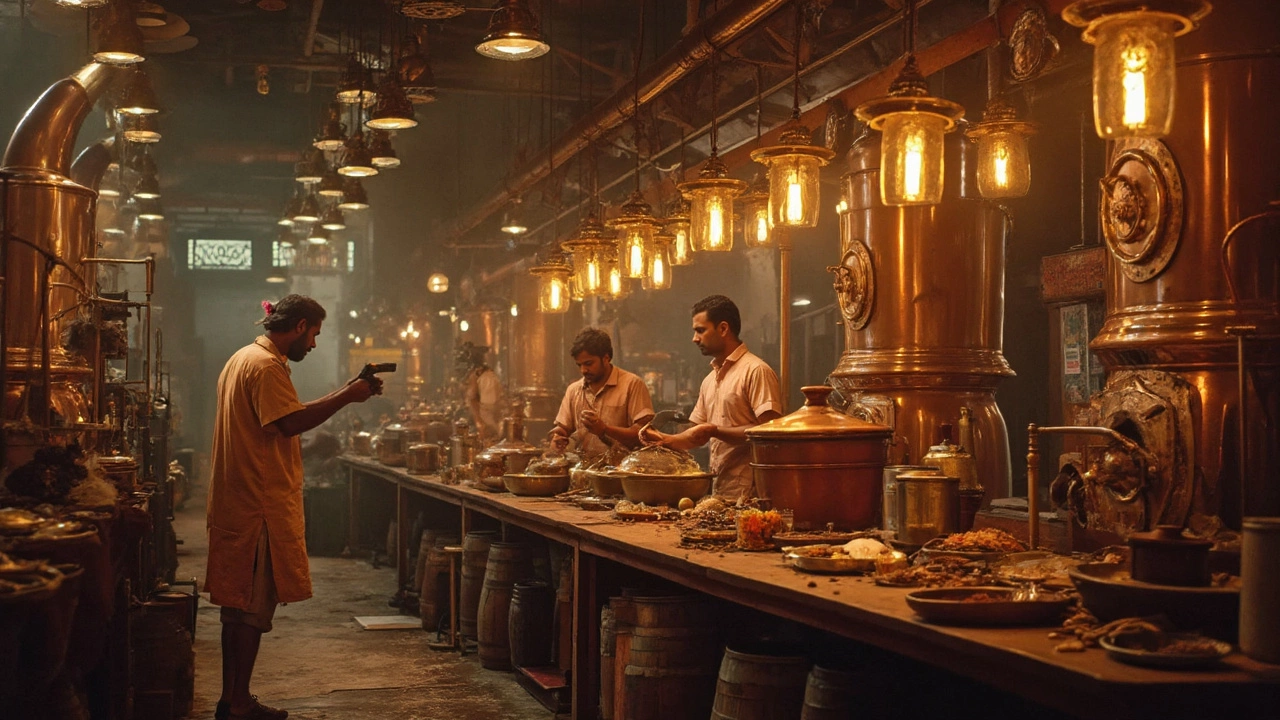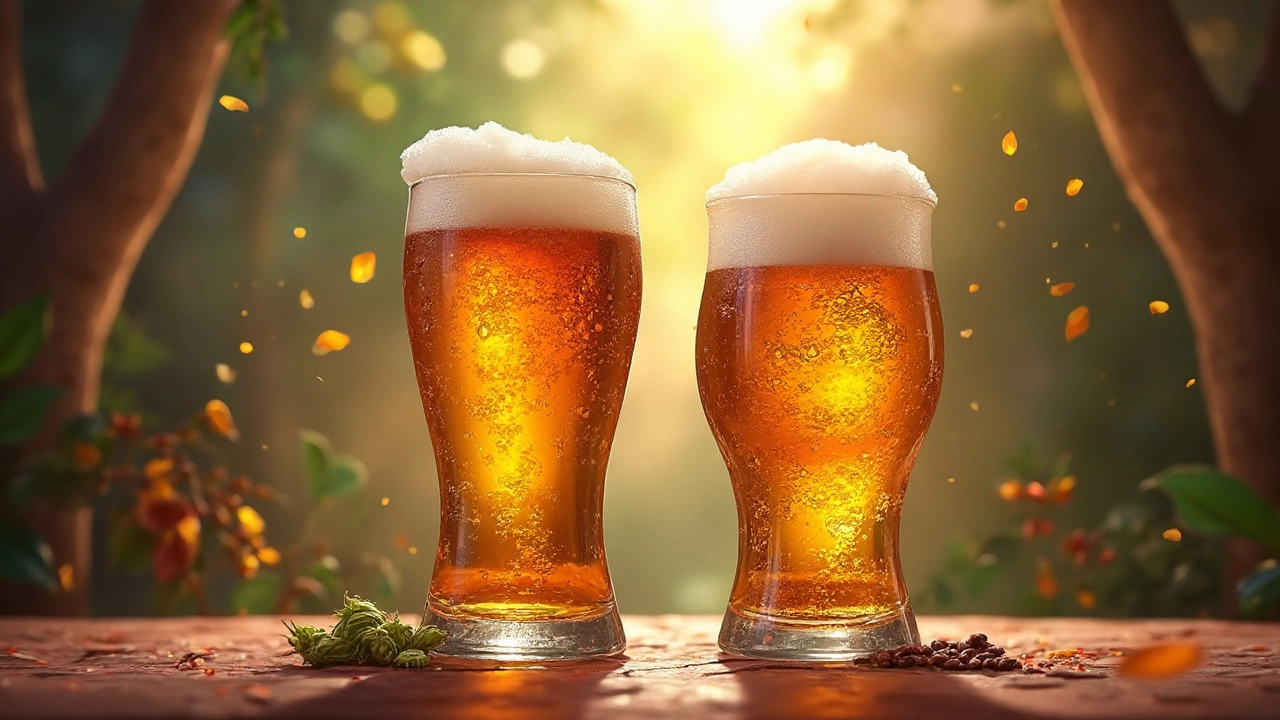
People are always on the lookout for healthier lifestyle options, even when it comes to their brews. If you've been wondering whether craft beer is a smarter choice over regular beer, you're not alone. Craft beer's popularity has soared lately, claiming a spot in the hearts of many. But what makes it so special?
First off, let's talk about what's in your glass. Craft beer is often celebrated for its artisanal approach—it's all about the quality and variety of ingredients. Brewers tend to use more diverse grains, hops, and malts. This can mean fewer additives and preservatives compared to mass-produced beers.
Now, we can't ignore the elephant in the room—calories and alcohol content. Craft beer often packs a punch, sometimes with higher alcohol levels and therefore more calories. But then again, this isn't a universal rule. Some craft brews, like lighter ales or lagers, might rival regular beers in calorie count.
- The Craft Beer Craze
- What's in Your Glass?
- Comparing Ingredients
- Alcohol Content and Calories
- Potential Health Benefits
- Home Brewing Your Own
The Craft Beer Craze
The world of craft beer has exploded in recent years, creating a whole new experience for beer lovers. This isn't just about cracking open a cold one anymore—it's about savoring every sip and knowing the story behind it. So, why exactly has craft beer carved out a special place in our hearts?
One big factor is the sheer variety and creativity that's possible with craft brewing. Unlike regular beer producers who often stick to the same formulas, craft brewers are inventing new recipes all the time. You might find a mango habanero IPA one day and a chocolate stout the next! This flexibility allows for regional twists and seasonal specials that keep things exciting.
Beyond the Mainstream
Craft breweries prioritize quality over quantity. Instead of mass production, they focus on smaller batches that may offer better tastes and stronger flavors. This personal touch often means using local or organic ingredients, reducing the need for artificial additives. Not only does this enhance flavor, but it might make some craft beers a slightly healthier pick over regular options.
Additionally, the community aspect is hard to ignore. Craft breweries often become social hubs, hosting events, and supporting local causes. It's not just about the beer; it's about a sense of belonging. This tight-knit community vibe can make every pint feel like a shared experience.
Numbers Speak
Curious about the scale of this movement? A quick glance at recent stats shows the trend isn't slowing down. Here's a snippet:
| Year | Craft Breweries in the US |
|---|---|
| 2020 | 8,764 |
| 2023 | 9,247 |
As these numbers show, more people are jumping on the home brewing bandwagon, buying home brewing kits, and trying their hand at creating something unique.
So, whether you're a seasoned craft beer enthusiast or just dabbling, there's a world of flavor to explore. With every sip, you're not just tasting a beverage; you're experiencing a movement.
What's in Your Glass?
Let's break down the different ingredients and what they mean for both craft beer and regular beer. When you're sipping on that flavorful pint, here’s what’s likely mixed in there.
Malt and Grains
The backbone of any beer lies in its malt and grain selection. Normally, beers contain barley malt, but craft beers often venture into the world of other grains like wheat, rye, or oats. These choices can change the brew's taste and nutritional profile.
Hop Choices
Hops give beer its bitterness and aroma. In craft beer, the use of unique and diverse hops is quite common, resulting in bold and sometimes surprising flavors. Regular beers, on the other hand, tend to stick with traditional hop varieties, which keeps their flavor more predictable.
Yeast and Fermentation
The yeast used in brewing is responsible for converting sugars to alcohol. Craft brewers may experiment with wild yeasts to achieve new and complex profiles, whereas regular beers often use tried-and-true options for more consistent results. This experimentation can lead to unique flavors and textures in craft beers.
Additives and Preservatives
One of the main differences lies in additives and preservatives. Regular beers might have more of these to ensure long shelf life and consistent taste. In contrast, many craft brewers pride themselves on avoiding unnecessary additives and preservatives, focusing on fresh and natural ingredients to entice their audience.
Ingredient Transparency
Transparency about what goes into your beer can be more apparent with crafts. Breweries are often keen to share their ingredient choices and brewing process with consumers, enlightening drinkers about their drink’s makeup.
Overall, understanding what's swirling in your glass can help you make informed decisions about what kind of beer best suits your health-conscious lifestyle. And next time you pick up that home brewing kit, you’ll know exactly which ingredients might give you that edge you’re looking for.
Comparing Ingredients
When you crack open a craft beer, what exactly goes into it compared to the usual store-bought stuff? At its core, beer is a simple mix of water, malted barley, hops, and yeast. But the magic lies in how these ingredients are selected and used.
The Grain Game
Mass-produced beers generally stick to basic grains, leaning heavily on cost-effective adjuncts like rice and corn to bulk up. These don't always add much flavor. Craft beer makers, on the other hand, often use a variety of malts, from chocolate to caramel, creating complex flavors and aromas.
Hops, Glorious Hops
Hops are the spice rack of beer, and craft brewers aren't shy about experimenting. While regular beer relies on just a few hop varieties, the craft beer world embraces a rainbow of flavors, from citrusy to floral to earthy, resulting in a dynamic range of bitterness and aroma.
Yeast: The Unsung Hero
Yeast not only ferments the beer but also contributes to its flavor. Most commercial beers use a standard yeast strain for consistency. But in craft beer, unique yeast strains can brew anything from peppery Belgian ales to fruity pale ales, adding more depth.
| Ingredient | Mass-produced Beer | Craft Beer |
|---|---|---|
| Grains | Basic, often includes adjuncts like rice/corn | Variety, premium oats and specialty malts |
| Hops | Few common varieties | Diverse selection, bold flavors |
| Yeast | Standard strains | Often custom for unique profiles |
In short, it's the attention to detail and creativity with these ingredients that sets craft beer apart. Whether it's health benefits or flavor, knowing what's in your beer can make all the difference in your choice.

Alcohol Content and Calories
Alright, let's break it down: the relationship between alcohol content and calorie count in craft beer versus regular beer. If you've ever wondered why that delicious IPA costs you more in calories, you're in the right place.
Craft beers often boast higher alcohol by volume (ABV) percentages than your typical mass-produced brew. Why? It's all about the crafting process. Brewers often aim for bold flavors, which come from using more malt. More malt means more sugar to ferment into alcohol, often leading to higher ABV.
What's the Calorie Count?
Let's put this into perspective with some rough numbers. A typical regular lager might clock in around 4-5% alcohol and have roughly 150 calories per 12-ounce serving. Meanwhile, a craft beer like a double IPA could soar past 7% ABV and hit close to 350 calories for the same serving size. That's quite a jump in the calorie department!
However, not all craft beers are calorie bombs. Many ringanized options, like pale ales or session beers, are designed with both flavor and lighter drinking in mind, sometimes sitting comfortably around the same calorie range as a standard lager.
Finding Balance
So, how do you enjoy the world of craft without overloading on calories? Here are a few tips:
- Check the ABV: Opt for craft beers with lower ABV if you're watching your calorie intake.
- Mind the Portion: Enjoy smaller servings to savor the variety without overdoing it.
- Mix it Up: Alternate between drinking water and beer to stay hydrated and potentially drink less overall.
In the end, it's about knowing your drink and choosing what's right for your lifestyle. Enjoying craft beer is all about experiencing diverse flavors, and with these tips, you can do so without any guilt.
Potential Health Benefits
Alright, so we've heard the rumors—can craft beer actually be good for you? It's no miracle drink, but there are some interesting perks to consider.
First off, craft beer often contains higher levels of vitamins, minerals, and antioxidants compared to its regular counterparts. This is because craft brewers tend to use a higher variety and quality of ingredients, often retaining more of the grains and hops' natural nutrients during brewing.
Antioxidants Galore
The antioxidants in craft beers originate from hops and malt, which are rich in phenolic compounds. Antioxidants are known to help combat free radicals in the body and could reduce inflammation. So, yes, you might get a tiny health boost while savoring your favorite sour ale or stout.
B Vitamins and Fiber
Beer, including the craft beer variety, contains several B vitamins such as B6, B3, and B9. These are essential for converting our food into energy and maintaining healthy cells. The yeast left in some unfiltered craft beers can also contribute dietary fiber, promoting better digestion.
Moderation is Key
Before you get too excited, keep in mind that these benefits come when you enjoy your craft beer in moderation. Overindulging can negate these benefits, leading to unwanted health issues. Moderation is the name of the game!
So, if you're pouring yourself a glass, doing so mindfully can possibly tick off more positives than you'd get from a regular, mass-produced brew. Cheers to that!
Home Brewing Your Own
Diving into the world of home brewing can be as thrilling as it is rewarding. Not only do you gain complete control over your beer's ingredients, but it's a chance to create something unique. Plus, brewing your own `craft beer` can indeed lean on the healthier side, since you decide what goes into the mix.
Gathering Your Gear
First things first, you need the right tools. Home brewing kits are a great start, often including essentials like fermenters, airlocks, and a hydrometer. Getting these basics down is crucial before you even think about brewing your first batch. One study found that beginners enjoy a smoother process if they thoroughly understand each tool's purpose first.
Ingredients Matter
The beauty of brewing at home is experimenting with ingredients. Typical beer requires water, malted barley, hops, and yeast. Want fewer calories? Opt for a `craft beer` style with light malts. Interested in unique flavors? Try adding spices or fruits. For example, it's becoming trendy to incorporate local Scottish ingredients like heather or honey for an authentic twang.
Steps to Get Brewing
- Sanitize everything. Cleanliness is key to avoiding unwanted bacteria.
- Heat up the water and add your malt to create a mixture known as 'wort'.
- Bring this wort to a boil, then add hops for flavor and aroma.
- Cool the wort quickly and pour it into your fermenter, adding yeast to start fermentation.
- Seal it with an airlock, and let it sit for about two weeks.
- After fermenting, it's time to bottle your beer and let it carbonate for another couple of weeks.
How Much Will it Cost?
Let's talk numbers. Initial setup costs vary, but a basic `home brewing` kit can be had for around £50-£100. Ingredients for each batch might set you back further £20-£40, which is quite reasonable considering you're producing gallons at a time.
| Item | Cost Range (£) |
|---|---|
| Brewing Kit | 50-100 |
| Ingredients per Batch | 20-40 |
In the end, whether you're motivated by health, curiosity, or the lure of crafting unique flavors, home brewing offers a fulfilling endeavor. So why not grab a `home brewing kit` and start exploring the art of `craft beer`?





Categories